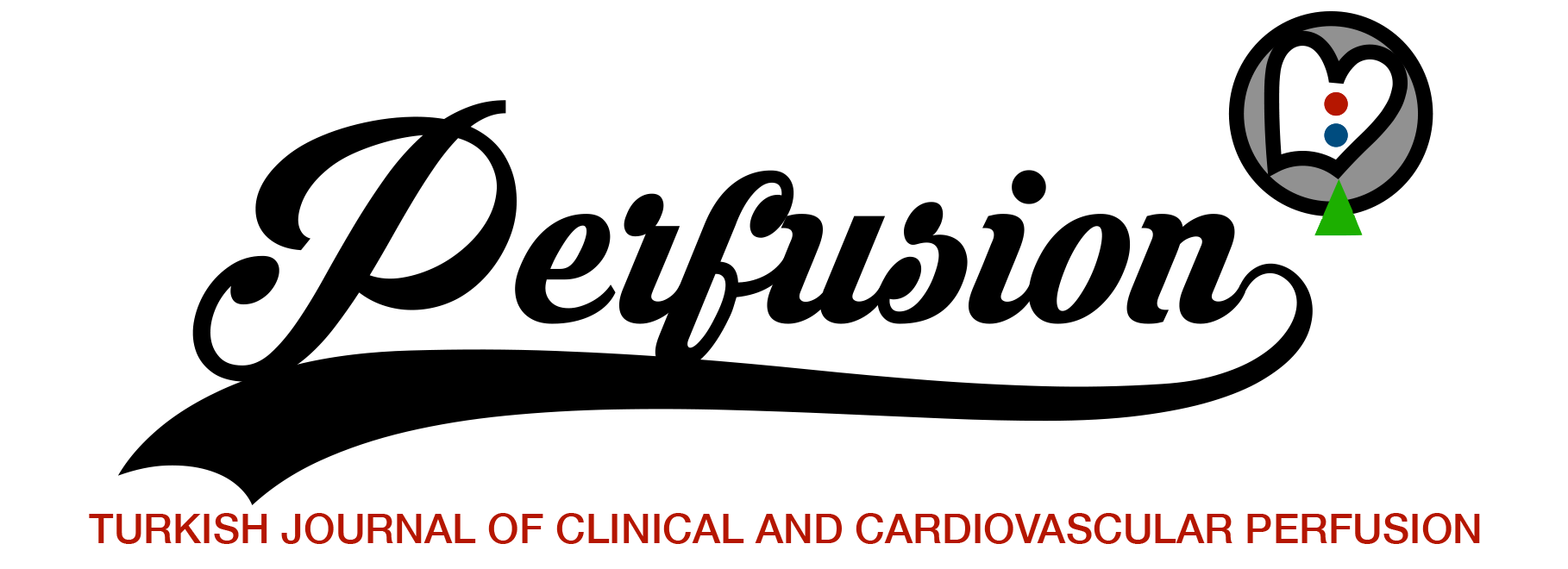ABSTRACT
Objective:
We aimed to determine the hemodynamic effects of the use of vacuum-assisted venous drainage (VAVD) in open heart surgery and the risks for perfusionists.
Materials and Methods:
Patients who underwent robotic or minimally invasive open heart surgery with VAVD (n=20) and open heart surgery with traditional venous drainage (n=20) were compared retrospectively.
Results:
There was no difference between the groups in terms of demographic patient characteristics, blood pressure during cardiopulmonary bypass (CPB), pump flow, cross clamp time, pump balance, and intope requirement. However, the group 1 pump time was statistically significantly longer. In group 1, postoperative 1st day hemoglobin and leukocyte values were found to be higher than in group 2, and postoperative 2nd and 3rd day thrombocyte values were found to be lower. However, no statistically significant difference was found in terms of erythrocyte suspension, thrombocyte suspension, and fresh frozen plasma used in the perioperative and postoperative periods. There were no statistically significant differences between the groups in terms of C-reactive protein, blood urea nitrogen, creatinine, and estimated glomerular filtration rate values, and duration of intensive care unit and hospital stay. In our study, hemolysis was observed in 2 cases in group 1 and in 4 cases in group 2.
Conclusion:
It is seen that the VAVD method applied with a vacuum of -40 mmHg provides adequate CPB perfusion hemodynamics when compared with open heart surgery cases in which venous drainage is applied with the traditional method. We believe that it can be safely used in robotic and minimally invasive open heart surgery with adequate CPB perfusion hemodynamics without causing additional complications due to negative pressure with similar perioperative and postoperative outcomes.
Keywords:
Vacuum assisted venous drainage, open heart surgery, cardiopulmonary bypass, increased venous return, gravity drainageoperative parameters.
References
1Ak K. Kardiyopulmoner bypass ve optimal koşulları. In: Kalp ve Anestezi, Dönmez A (editör). 1. Baskı. Ankara: Intertıp Yayınevi, 2015:121-140.
2Willcox TW. Vacuum assist: angel or demon CON. J Extra Corpor Technol 2013;45(2):128-132.
3Gao S, Li Y, Diao X, Yan S, Liu G, Liu M, et al. Vacuum-assisted venous drainage in adult cardiac surgery: a propensity-matched study. Interact Cardiovasc Thorac Surg 2020;30(2):236-242.
4Wang JL, Li JC, Li JC, Gao CQ, Zhang T. Perfusion strategies of extracorporeal circulation for robotically assisted cardiac surgery. Nan Fang Yi Ke Da Xue Xue Bao 2009;29(11):2300-2301.
5Durandy Y. Vacuum-assisted venous drainage, angel or demon: PRO? J Extra Corpor Technol 2013;45(2):122-127.
6Sabzi F, Faraji R. Liver Function Tests Following Open Cardiac Surgery. J Cardiovasc Thorac Res 2015;7(2):49-54.
7Marin Cuartas M, Javadikasgari H, Pfannmueller B, Seeburger J, Gillinov AM, Suri RM, et al. Mitral valve repair: Robotic and other minimally invasive approaches. Prog Cardiovasc Dis 2017;60(3):394-404.
8Amaç B, Koçarslan A, Aydın MS, Kankılıç N, Padak M, Dikme R. The Effect of Cardiopulmonary Bypass on Hemogram Parameters. OTJHS 2021;6(1):102-111.
9Banbury MK, White JA, Blackstone EH, Cosgrove DM 3rd. Vacuum-assisted wenous return reduces blood usage. J Thorac and Cardiovasc Surg 2003;126(3):680-687.
10Bevilacqua S, Matteucci S, Ferrarini M, Kacila M, Ripoli A, Baroni A, et al. Biochemical evaluation of vacuum-assisted venous drainage: a randomized, prospective study. Perfusion 2002;17(1):57-61.
11Chalegre ST, Salerno PR, Salerno LM, Melo AR, Pinheiro AC, Frazão Cda S, et al. Vacuum-assisted venous drainage in cardiopulmonary bypass and need of blood transfusion: experience of service. Rev Bras Cir Cardiovasc 2011;26(1):122-127.
12Kabalcı M. Removal of oxygenator from pump system in open heart surgery: experimental animal study. J Health Sci Med 2019;2(4):121-128.
13Aydin S, Cekmecelioglu D, Celik S, Yerli I, Kirali K. The effect of vacuum-assisted venous drainage on hemolysis during cardiopulmonary bypass. Am J Cardiovasc Dis 2020;10(4):473-478.
14Kiyama H, Imazeki T, Katayama Y, Murai N, Mukouyama M, Yamauti N. vacuum-assisted venous drainage in single-access minimally invasive cardiac surgery. J Artif Organs 2003;6(1):20-24.
15Goksedef D, Omeroglu SN, Balkanay OO, Denli Yalvac ES, Talas Z, et al. Hemolysis at different vacuum levels during vacuum-assisted venous drainage: a prospective randomized clinical trial. Thorac Cardiovasc Surg 2012;60(4):262-268.
16Kwak JG, Lee J, Park M, Seo YJ, Lee CH. Hemolysis During Open-Heart Surgery With Vacuum-Assisted Venous Drainage at Different Negative Pressures in Pediatric Patients Weighing Less Than 10 kilograms. World J Pediatr Congenit Heart Surg 2017;8(2):161-165.
17Mueller XM, Tevaearai HT, Horisberger J, Augstburger M, Burki M, von Segesser LK. Vacuum Assisted venous drainage does not ıncrease trauma to blood cells. ASAIO J 2001;47(6):651-654.
18Dybdahl B, Wahba A, Haaverstad R, Kirkeby-Garstad I, Kierulf P, Espevik T, et al. On-pump versus off-pump coronary artery bypass grafting: more heat-shock protein 70 is released after on-pump surgery. Eur J Cardiothorac Surg 2004;25(6):985-992.
19Schulze C, Conrad N, Schütz A, Egi K, Reichenspurner H, Reichart B, et al. Reduced expression of systemic proinflammatory cytokines after off-pump versus conventional coronary artery bypass grafting. Thorac Cardiovasc Surg 2000;48(6):364-369.
20Wan IYP, Arifi AA, Wan S, Yip JH, Sihoe AD, Thung KH, et al. Beating heart revascularization with or without cardiopulmonary bypass: evaluation of inflammatory response in a prospective randomized study. J Thorac Cardiovasc Surg 2004;127(6):1624-1631.
21Hosono M, Yasumoto H, Kuwauchi S, Mitsunaga Y, Kanemoto S, Minato N, et al. Utility of Ultrasonographic Assessment of Distal Femoral Arterial Flow during Minimally Invasive Valve Surgery. Ann Thorac Cardiovasc Surg 2021;27(6):389-394.
22Marasco SF, Tutungi E, Vallance SA, Udy AA, Negri JC, Zimmet AD, et al. A Phase 1 Study of a Novel Bidirectional Perfusion Cannula in Patients Undergoing Femoral Cannulation for Cardiac Surgery. Innovations (Phila) 2018;13(2):97-103.
23Matsui Y, Shimura S, Suto Y, Fukase S, Tanaka A, Sasaki S. A novel femoral arterial cannula to prevent limb ischemia during cardiopulmonary support: preliminary report of experimental and clinical experiences. Artificial Organs 2006;30(7):557-560.
24Willcox TW, Mitchell SJ, Gorman DF. Venous air in the bypass circuit: a source of arterial line emboli exacerbated by vacuum-assisted drainage. Ann Thorac Surg 1999;68(4):1285-1289.
25Wang S, Baer L, Kunselman AR, Myers JL, Undar A. Delivery of gaseous microemboli with vacuum-assisted venous drainage during pulsatile and nonpulsatile perfusion in a simulated neonatal cardiopulmonary bypass model. ASAIO J 2008;54(4):416-422.
26Lapietra A, Grossi EA, Pua BB, Esposito RA, Galloway AC, Derivaux CC, et al. Assisted venous drainage presents the risk of undetected air microembolism. J Thorac Cardiovasc Surg 2000;120(5):856-862.
27Carrier M, Cyr A, Voisine P, Pellerin M, Perrault LP, Cartier R, et al. Vacuum-assisted venous drainage does not increase the neurological risk. Heart Surg Forum 2002;5(3):285-288.
28Lou S, Ji B, Liu J, Yu K, Long C. Generation, detection and prevention of gaseous microemboli during cardiopulmonary bypass procedure. Int J Artif Organs 2011;34(11):1039-1051.
29Wang S, Undar A. Vacuum-assisted venous drainage and gaseous microemboli in cardiopulmonary bypass. J Extra Corpor Technol 2008;40(4):249-256.



